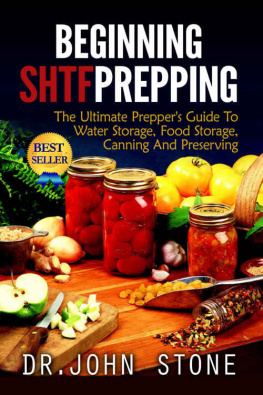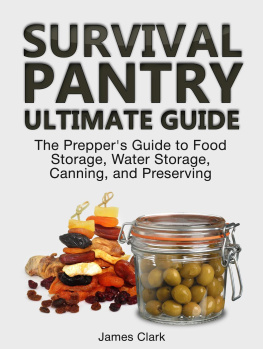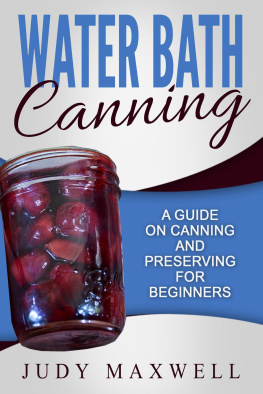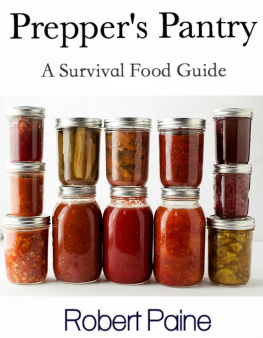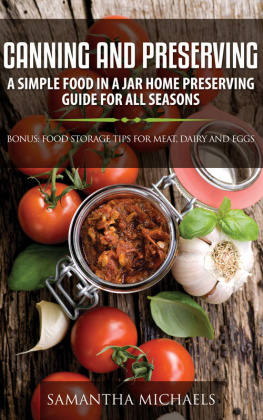Beginning SHTF Prepping

The Ultimate Prepper's Guide To Water Storage, Food Storage, Canning And Preserving
Dr John Stone
Copyright2014 Dr John Stone
This book or any portion thereof may not be reproduced or used in any way whatsoever without the written consent of the Author except for the purpose of brief quotations for book reviews.
Disclaimer
This book is intended to be a general guide, to raise awareness, and to help people make informed decisions in the context of their own personal circumstance.
The author accepts no responsibility for any loss or injury be it personal or financial, as a result for the use or misuse of the information in this book. If you have any doubts or concerns after reading this book, please speak to a qualified person before taking any actions.
Table of Contents
Introduction
You never know when disaster is going to strike. Disaster can come in many different forms. You could be stuck in the middle of a severe snow storm that cripples the city and knocks out power for days or you could live in an area that has just suffered some kind of major upheaval like civil unrest or a terrorist attack. These are things that can and have happened. Some people were prepared and were able to ride out the aftermath of a storm in relative comfort, while others were left without food, water and basic necessities.
We have seen time and again that our governments can only provide so much aid. That aid isn't going to be instant. It will take several days for the government to mobilize and start bringing in supplies. If the situation is severe, it could take much longer than that. Governments have learned by past incidents that it will take them at least 3 days before they can start to bring in food, medical supplies and clean drinking water. For that reason, it is almost a requirement that every household have at least a 3-day supply of food and water on hand.
However, 3 days isn't very long and what if you are on the outskirts of town or the disaster you have been a victim of is so severe roads in and out of the city are completely blocked. You would have to survive much longer without the help of your government, the Red Cross or even the local grocery store. You are on your own! This book will help you prepare for anything so you will have peace of mind that your family will be taken care of no matter what comes your way.
You need to know just how much food and water you should really be storing for your particular situation. You also need to know what kinds of foods. No one food pantry is going to suit everybody. Your family has different needs and taste preferences than the guy next door. Learn how to tailor an emergency food storage so you can keep your family healthy and happy. When you are cooped up together, being happy is pretty important.
Storing food and water doesn't necessarily mean you have to spend hundreds of dollars at the local grocery store. You can certainly preserve your own food using several different methods, which are all covered in this book. It is much more cost effective and you will know exactly what it is you are feeding your family.
You also need to know how to ration your available food and water. The local foodmart is not going to be operational. You have to make do with what you have on hand when disaster strikes. If the worst happens and you run out of food and water, do you know how to scavenge to find more?
There are a lot of bases to cover when it comes to being prepared for anything. This book will help you cover all of those bases while teaching you some new skills. Don't put off your emergency preparations. You never know when the next storm is headed your way. You need to start preparing today!
Chapter 1:
Planning Your Food And Water Supply For the Short, Medium & Long Term Emergencies
Planning for Emergencies
Sometimes, it goes without saying Prevention is better than cure. It is indeed, true. When you have planned what to do, it makes things easier for you to organize your resources. Please bear in mind that it's always better to have it, even if you dont need it, than to need it, but you totally dont have it. Emergencies always happen every time we dont expect them.
There are things that we need to consider in starting our emergency food pantry. Consider the shelf life of the food; you dont want to end up eating a rotten or spoiled food in order to survive right? You also need consider that the stored food you have is enough to sustain your entire family; you dont want to see their hungry faces during these situations, do you? On top of that, it is a must to consider what to store, how to store it, and how much you do need to store.
Short Term Emergencies
Short term emergencies are those emergencies that last at least a day up to a couple of weeks. Planning for such emergencies is not as meticulous as planning for long term ones.
Water and food storage during this type of emergencies should be quickly accessed. Find food and water that can supply you and your family with enough energy for several days. Bear in mind that a person needs a gallon of drinking water each and every day. Water should never be compromised at any times. A certain individual can last a maximum of ten days without drinking water, starting at 26 Celsius; your life span decreases a day every time the temperature increases by 5 degrees. You dont want to see your family slowly dying just because of thirst or dehydration.
Chosen foods should be those that are readytoeat without the need of cooking, re-heating or refrigeration, because the electricity might be shut off. You dont want to end up eating raw foods. Commercially, canned foods are the best choices, since they do not require cooking or refrigeration.
During short-term emergencies, you should look for calories and comfort foods. Are you aware of what comfort foods are? Comfort foods are high in carbohydrates, and it is exactly what your body will need. While dealing with an emergency situation, do not worry about vitamins or nutrients you will not receive for a short period. If any family members have any health issues, make sure you dont forget any medicines or special foods they may need during an emergency. Dont forget, if you have a baby, then please make sure you have an elaborate plan to keep the milk from spoiling. You never want to see your baby crying due to an empty stomach, right?
Medium Term Emergencies
Medium term emergencies are those, which can last from three weeks to three months. These type of emergencies where food and water supply can be interrupted for various reasons. Hurricane Katrina is one perfect example of emergency where roads are inaccessible, thus making it hard for relief goods to enter the community.
When you are preparing for emergency situations, try to gather foods that are part of your daily diet. These should not be all canned goods. You can purchase cases of water, grains, cereals, beans and powdered milk. You may start buying some of these items weekly until you finally reach your goal. You can also try to do homemade preservation of foods like drying of fish and fruits, etc. for medium emergencies. You should look for calorie-rich foods and at least find time to sustain the daily nutrients your body needs. We will discuss the homemade preservation later in the book.
Long Term Emergencies
Long term emergencies are those types of emergencies that could last from few months to a year. These types of emergencies may happen less often, but it is still better to be prepared just in case it might occur.
Long term food supplies can be a mixture of canned goods and low moisture foods that can last for several of months or years. Be sure though, that you get all the nutrients you need during the whole duration of the emergency.
Next page
